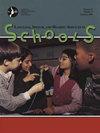Analyzing the Impact of Four Cognitive Constructs on Nonverbal Intelligence Test Performance: Implications for Children With Neurodevelopmental Disorders.
IF 2.9
3区 医学
Q1 AUDIOLOGY & SPEECH-LANGUAGE PATHOLOGY
Language Speech and Hearing Services in Schools
Pub Date : 2025-05-14
DOI:10.1044/2025_lshss-24-00056
引用次数: 0
Abstract
PURPOSE Children with neurodevelopmental disorders historically exhibit lower and more variable nonverbal intelligence (NVIQ) scores compared to their typically developing peers. We hypothesize that the intrinsic characteristics of the tests themselves, particularly the cognitive constructs they assess, may account for both the lower scores and variability across tests and over time. Using a qualitative content analysis approach, we examined the extent to which key cognitive constructs are engaged in NVIQ tests and how these constructs compare across different tests. METHOD Current editions of seven NVIQ tests were selected based on their relevance in clinical and research settings. Qualitative coding of constructs was developed iteratively by speech-language pathologists and researchers. The codes focused on cognitive domains most affected in highly prevalent neurodevelopmental conditions, including attention, receptive language, statistical learning, and working memory. RESULTS We identified multiple subfeatures for our constructs of interest. Using this coding framework, we found that NVIQ tests qualitatively differ in the extent to which these four constructs influence test performance. CONCLUSIONS Our findings suggest that understanding the impact of cognitive constructs on NVIQ tests can help explain why children with neurodevelopmental disorders exhibit lower and more unstable NVIQ scores compared to their peers. We provide recommendations for the use of NVIQ tests with neurodevelopmental disorder populations and encourage researchers and clinicians in speech and hearing sciences and psychology to use our results to inform test interpretation and selection. SUPPLEMENTAL MATERIAL https://doi.org/10.23641/asha.28886957.分析四种认知构念对非语言智力测验成绩的影响:对神经发育障碍儿童的影响。
目的:与正常发育的同龄人相比,患有神经发育障碍的儿童在历史上表现出更低、更多变的非语言智力(NVIQ)得分。我们假设,测试本身的内在特征,特别是他们评估的认知结构,可能解释了较低的分数和测试之间和随着时间的变化。使用定性内容分析方法,我们检查了关键认知结构在NVIQ测试中的参与程度,以及这些结构在不同测试中的比较情况。方法根据其在临床和研究环境中的相关性选择当前版本的7个NVIQ测试。构念的定性编码是语言病理学家和研究人员反复开发的。这些代码集中在高度普遍的神经发育条件下最受影响的认知领域,包括注意力、接受性语言、统计学习和工作记忆。结果我们为我们感兴趣的构造确定了多个子特征。使用这个编码框架,我们发现NVIQ测试在这四种结构对测试性能的影响程度上有质的不同。结论我们的研究结果表明,理解认知构式对NVIQ测试的影响有助于解释为什么神经发育障碍儿童的NVIQ分数比同龄人低且更不稳定。我们为神经发育障碍人群使用NVIQ测试提供建议,并鼓励言语、听力科学和心理学领域的研究人员和临床医生使用我们的结果来指导测试的解释和选择。补充MATERIALhttps: / / doi.org/10.23641/asha.28886957。
本文章由计算机程序翻译,如有差异,请以英文原文为准。
求助全文
约1分钟内获得全文
求助全文
来源期刊

Language Speech and Hearing Services in Schools
Social Sciences-Linguistics and Language
CiteScore
4.40
自引率
12.50%
发文量
165
期刊介绍:
Mission: LSHSS publishes peer-reviewed research and other scholarly articles pertaining to the practice of audiology and speech-language pathology in the schools, focusing on children and adolescents. The journal is an international outlet for clinical research and is designed to promote development and analysis of approaches concerning the delivery of services to the school-aged population. LSHSS seeks to advance evidence-based practice by disseminating the results of new studies as well as providing a forum for critical reviews and meta-analyses of previously published work.
Scope: The broad field of audiology and speech-language pathology as practiced in schools, including aural rehabilitation; augmentative and alternative communication; childhood apraxia of speech; classroom acoustics; cognitive impairment; craniofacial disorders; fluency disorders; hearing-assistive technology; language disorders; literacy disorders including reading, writing, and spelling; motor speech disorders; speech sound disorders; swallowing, dysphagia, and feeding disorders; voice disorders.
 求助内容:
求助内容: 应助结果提醒方式:
应助结果提醒方式:


